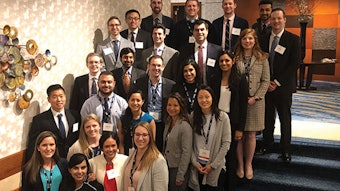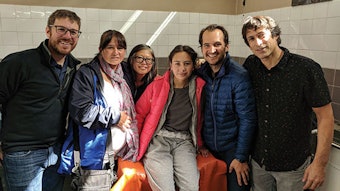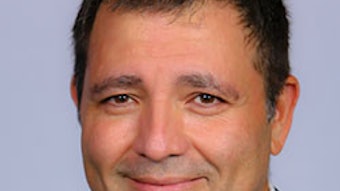Upper Airway Stimulation to treat Adult Obstructive Sleep Apnea
In this Bulletin segment, the American Academy of Otolaryngology–Head and Neck Surgery Foundation (AAO-HNSF) Outcomes Research and Evidence-Based Medicine (OREBM) Committee shares highlights from a 2017 study, “Upper Airway Stimulation for Obstructive Sleep Apnea: Patient-Reported Outcomes after 48 Months of Follow-up.”
OUT OF COMMITTEE: OREBM
Neerav Goyal, MD, MPH, Derek J. Lam, MD, MPH, and Vikas Mehta, MD, MPH, for the AAO-HNSF Outcomes Research and Evidence-Based Medicine (OREBM) Committee

In this Bulletin segment, the American Academy of Otolaryngology–Head and Neck Surgery Foundation (AAO-HNSF) Outcomes Research and Evidence-Based Medicine (OREBM) Committee shares highlights from a 2017 study, “Upper Airway Stimulation for Obstructive Sleep Apnea: Patient-Reported Outcomes after 48 Months of Follow-up.”1 The focus of this ongoing series is to highlight articles that may alter surgical practice, and to discuss the strengths and limitations of these publications.
Obstructive sleep apnea (OSA) is a condition affecting a significant portion of the adult and pediatric population, with OSA being a primary indication for tonsillectomy and adenoidectomy in children. Among adults, OSA is notably associated with hypertension, diabetes, asthma, heart disease, stroke, workplace and motor vehicle accidents, increased mortality and a decreased quality of life (QOL). The overall economic cost of untreated OSA as published in a 2015 commissioned report by the American Academy of Sleep Medicine (AASM) measured $149.6 billion2. Recent estimates suggest 13 percent of men and six percent of women in the U.S. have moderate to severe OSA, with the large majority being undiagnosed3.
While surgery is the primary modality for treating OSA in children, continuous airway positive pressure (CPAP) remains the standard treatment for adults. Though CPAP is an effective treatment modality, long-term compliance with therapy remains low2,4,5. Adult sleep surgery has long been in the armamentarium of the otolaryngologist, with variable efficacy and long-term success with traditional techniques. More recently, research into hypoglossal nerve stimulation has led to the development and approval by the FDA (in 2014) of an upper airway stimulator (UAS). The stimulator device includes a stimulator cuff placed on the distal hypoglossal nerve, a pulse generator placed within a subcutaneous pocket in the chest, and an intercostal respiratory-sensing lead.
This longitudinal observational study investigated 48-month long-term results from patients implanted with a UAS as part of the phase III multi-center Stimulation Therapy for Apnea Reduction (STAR) trial that led to FDA approval of this device. Patients included in the trial were those with moderate to severe OSA and intolerance or non-compliance with CPAP. Exclusion criteria included BMI > 32, neuromuscular disease, cardiopulmonary disorders, active psychiatric disease, comorbid non-respiratory sleep disorders, an apnea/hypopnea index (AHI) <20 or >50, central or mixed apneas >25 percent of the AHI, non-supine AHI < 10, anatomic abnormalities that would prevent effective use of the device (e.g., tonsillar hypertrophy), or complete concentric collapse at the level of the velum on drug-induced sleep endoscopy.
A total of 126 patients were included and underwent UAS implantation. Prior reported results demonstrated a reduction in 12-month AHI from a median of 29.3 to 9.0 at one year post implantation6. This study reviewed secondary outcomes at 48 months, including subjective sleepiness and QOL related to sleep using the Epworth Sleepiness Scale (ESS) and Functional Outcomes of Sleep Questionnaire (FOSQ). The authors also evaluated continued patient-reported compliance with therapy and snoring intensity. At 48 months, 91 patients remained in the study with complete data, and four patients with incomplete data.
Analysis of the above QOL outcomes demonstrated a median FOSQ score of 18.6, which was significantly improved from baseline. However, the average score (17.5) was still below fully normal values (>17.9). The ESS median score was six with an average significantly improved from baseline and within the range of normal. Both outcome measures were notably consistent over time since intervention. Additional outcomes measured included 91 percent of subjects and 85 percent of bed partners reporting none or only soft snoring at 48 months compared to 22 percent and 17 percent at baseline, respectively. Less than one percent of bed partners left the room at night as compared to 30 percent at baseline. Seventy-five (81 percent) of the subjects reported continued nightly use of the device at 48 months, in contrast to <40 percent reporting > six months CPAP compliance in a separate prospective trial of more than 1,000 patients7. The study noted no difference in demographic characteristics between the patients actively in the study as compared to those without long-term follow up.
Over the study period, five serious adverse events were reported (four percent) with three patients undergoing elective explanation and two requiring revision surgeries to replace malfunctioning device components. Minor adverse events such as discomfort related to tongue stimulation, tongue abrasion, and incisional discomfort decreased over the follow-up period.
Findings and Recommendations:
Prior results from the STAR trial cohort have demonstrated UAS to be effective in treating OSA and reducing AHI in this selective CPAP non-compliant population at 36 months. The investigators demonstrate that adherence to UAS therapy is stable over the four-year follow-up period with minimal complications and consistent, significant improvement in functional and quality-related sleep outcomes. The authors also note that while the median FOSQ score was improved over baseline, patients within this cohort had persistent sub-normal scores. They also highlight that some patients require multiple modalities of therapy, specifically mentioning one patient who augmented UAS therapy with an oral appliance to further reduce the AHI and thus emphasizing the challenge of treating this chronic disorder. The study is limited by the loss of follow-up for more than 25 percent of the original cohort. Additionally, the generalizability of the study to larger OSA population is limited secondary to highly specific inclusion/exclusion criteria in selecting candidates eligible for implant. Overall, these data support the use of UAS in treating OSA in select patients and demonstrate consistent, long-term improvement of objective and subjective outcomes. An important next step will be to follow the efficacy and results of UAS going forward as the inclusion criteria continue to expand.
Bibliography
- Gillespie MB, Soose RJ, Woodson BT, et al. Upper Airway Stimulation for Obstructive Sleep Apnea: Patient-Reported Outcomes after 48 Months of Follow-up. Otolaryngol Neck Surg. 2017;156(4):765-771. doi:10.1177/0194599817691491
- Frost & Sullivan. Hidden Health Crisis Costing America Billions. Underdiagnosing and Undertreating Obstructive Sleep Apnea Draining Healthcare System. American Academy of Sleep Medicine; 2016. http://www.aasmnet.org/sleep-apnea-economic-impact.aspx. Accessed April 5, 2019.
- Peppard PE, Young T, Barnet JH, Palta M, Hagen EW, Hla KM. Increased Prevalence of Sleep-Disordered Breathing in Adults. Am J Epidemiol. 2013;177(9):1006-1014. doi:10.1093/aje/kws342
- Kribbs NB, Pack AI, Kline LR, et al. Objective measurement of patterns of nasal CPAP use by patients with obstructive sleep apnea. Am Rev Respir Dis. 1993;147(4):887-895. doi:10.1164/ajrccm/147.4.887



















